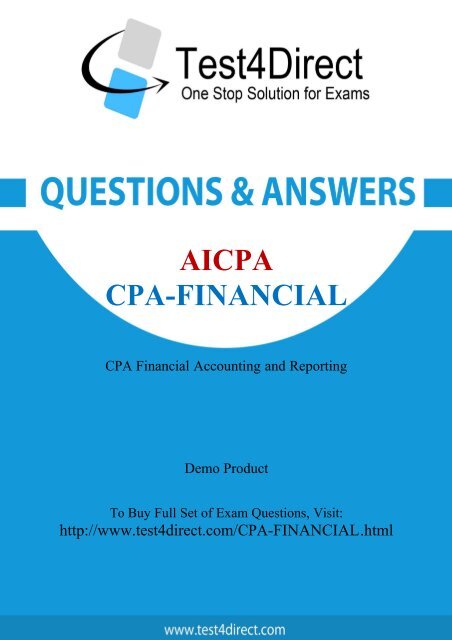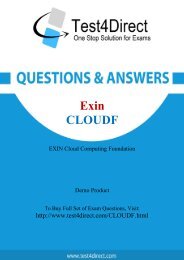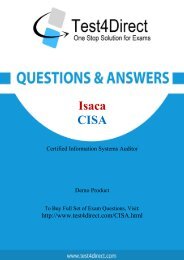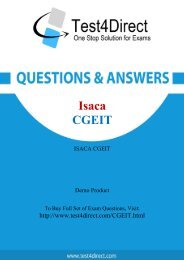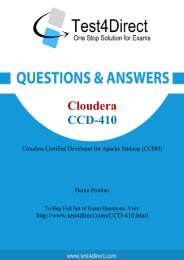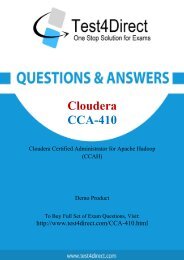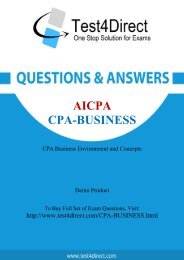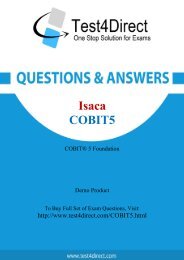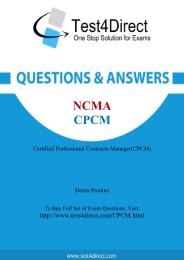Here you get free CPA-Financial Exam BrainDumps
Test4Direct provides latest PDF questions of AICPA CPA-Financial exam. You have an opportunity to pass the AICPA CPA-Financial exam in one go. Test4Direct is most accurate source to prepare AICPA CPA-Financial exam as your success will become site’s responsibility after purchasing CPA-Financial exam product. There are also lots of discounts and promotion offers that you can avail. Let’s try a free demo http://www.test4direct.com/CPA-Financial.html
Test4Direct provides latest PDF questions of AICPA CPA-Financial exam. You have an opportunity to pass the AICPA CPA-Financial exam in one go. Test4Direct is most accurate source to prepare AICPA CPA-Financial exam as your success will become site’s responsibility after purchasing CPA-Financial exam product. There are also lots of discounts and promotion offers that you can avail. Let’s try a free demo http://www.test4direct.com/CPA-Financial.html
Create successful ePaper yourself
Turn your PDF publications into a flip-book with our unique Google optimized e-Paper software.
AI<strong>CPA</strong><br />
<strong>CPA</strong>-FINANCIAL<br />
<strong>CPA</strong> <strong>Financial</strong> Accounting and Reporting<br />
Demo Product<br />
To Buy Full Set of <strong>Exam</strong> Questions, Visit:<br />
http://www.test4direct.com/<strong>CPA</strong>-FINANCIAL.html
Question: 1<br />
According to the FASB conceptual framework, the objectives of financial reporting for business<br />
enterprises are based on:<br />
A. Generally accepted accounting principles.<br />
B. Reporting on management's stewardship.<br />
C. The need for conservatism.<br />
D. The needs of the users of the information.<br />
Question: 2<br />
Question: 3<br />
Answer: D<br />
Explanation:<br />
Choice "d" is correct. The FASB conceptual framework states that the objectives of financial reporting<br />
stem from the informational needs of the external users of the information. SFAC 1 para. 28<br />
Choice "a" is incorrect. Generally accepted accounting principles (GAAP) are derived from and based<br />
on the objectives of financial reporting, not the other way around.<br />
Choice "b" is incorrect. Information concerning management's stewardship is only one aspect of the<br />
information financial statements are intended to provide. SFAC 1 para. 50<br />
Choice "c" is incorrect. Conservatism is an underlying concept for financial accounting but is not the<br />
basis for the objectives. SFAC 2 para. 91-97<br />
According to the FASB conceptual framework, the usefulness of providing information in financial<br />
statements is subject to the constraint of:<br />
A. Consistency.<br />
B. Cost-benefit.<br />
C. Reliability.<br />
D. Representational faithfulness.<br />
Answer: B<br />
Explanation:<br />
Choice "b" is correct. The pervasive constraint on providing information in financial statements is<br />
that the cost should be outweighed by the benefit to be derived from providing the information.<br />
SFAC 1 para. 23, SFAC 2 para. 133<br />
Choice "a" is incorrect. Consistency is an underlying concept for financial statements (and a<br />
secondary quality of accounting information), but it is not a constraint on providing information.<br />
SFAC 2 para. 120 Choice "c" is incorrect. Reliability is a primary quality of accounting information and<br />
an underlying concept for financial statements, but it is not a constraint on providing information.<br />
SFAC 2 para. 58 Choice "d" is incorrect. Representational faithfulness is an underlying concept for<br />
financial statements (as an element of reliability), but it is not a constraint on providing information.<br />
SFAC 2 para.
According to the FASB conceptual framework, which of the following attributes would not be used to<br />
measure inventory?<br />
A. Historical cost.<br />
B. Replacement cost.<br />
C. Net realizable value.<br />
D. Present value of future cash flows.<br />
Question: 4<br />
Question: 5<br />
Answer: D<br />
Explanation:<br />
Choice "d" is correct. The present value of future cash flows is used to measure long-term receivables<br />
or payables, not inventory, because inventory is a short-term asset, which has more immediate cash<br />
flows. SFAC 5 para. 67<br />
Choice "a" is incorrect. Historical cost can be used to measure inventory because it is a relevant and<br />
reliable measurement attribute of current assets such as inventory.<br />
Choice "b" is incorrect. Replacement (or current) cost can be used to measure inventory because it is<br />
a relevant and reliable measurement attribute of current assets such as inventory.<br />
Choice "c" is incorrect. Net realizable value can be used to measure inventory because it is a relevant<br />
and reliable measurement attribute of current assets such as inventory.<br />
According to the FASB conceptual framework, which of the following situations violates the concept<br />
of reliability?<br />
A. Data on segments having the same expected risks and growth rates are reported to analysts<br />
estimating future profits.<br />
B. <strong>Financial</strong> statements are issued nine months late.<br />
C. Management reports to stockholders regularly refer to new projects undertaken, but the financial<br />
statements never report project results.<br />
D. <strong>Financial</strong> statements include property with a carrying amount increased to management's<br />
estimate of market value.<br />
Answer: D<br />
Explanation:<br />
Choice "d" is correct. Management's estimate of market value lacks verifiability, which is a<br />
component of reliability. SFAC 2 para. 89<br />
Choice "a" is incorrect. Communicating data on segments to analysts does not violate the concept of<br />
reliability.<br />
Choice "b" is incorrect. Issuing financial statements nine months late violates timeliness, which is a<br />
component of relevance, not reliability. SFAC 2 para. 56<br />
Choice "c" is incorrect. Neglecting to report results of new projects violates full disclosure, not<br />
reliability.<br />
In the hierarchy of generally accepted accounting principles, APB Opinions have the same authority
as AI<strong>CPA</strong>:<br />
A. Statements of Position.<br />
B. Industry Audit and Accounting Guides.<br />
C. Issues Papers.<br />
D. Accounting Research Bulletins.<br />
Question: 6<br />
Question: 7<br />
Answer: D<br />
Explanation:<br />
Choice "d" is correct. AI<strong>CPA</strong> Accounting Research Bulletins, FASB Standards, FASB Interpretations,<br />
FASB Staff Positions, FASB Statement 133 Implementation Issues, and APB Opinions and<br />
Interpretations are the most authoritative sources of generally accepted accounting principles.<br />
Choice "a" is incorrect. AI<strong>CPA</strong> Statements of Position, AI<strong>CPA</strong> Accounting and Auditing Guides, and<br />
FASB Technical Bulletins are secondary sources of generally accepted accounting principles.<br />
Choice "b" is incorrect. AI<strong>CPA</strong> Statements of Position, AI<strong>CPA</strong> Accounting and Auditing Guides, and<br />
FASB Technical Bulletins are secondary sources of generally accepted accounting principles.<br />
Choice "c" is incorrect. AI<strong>CPA</strong> Issues Papers and Practice Bulletins, FASB Concepts Statements, and<br />
other authoritative pronouncements are tertiary sources for generally accepted accounting<br />
principles.<br />
What is the underlying concept that supports the immediate recognition of a contingent loss?<br />
A. Substance over form.<br />
B. Consistency.<br />
C. Matching.<br />
D. Conservatism.<br />
Answer: D<br />
Explanation:<br />
Choice "d" is correct. Conservatism is a prudent reaction to uncertainty to try to ensure that<br />
uncertainty and risks inherent in business situations are adequately considereD. Recognition of a<br />
contingent loss is the recording of an amount representing uncertainty and risk in a business<br />
situation. SFAC 2, SFAS 5 para. 82<br />
Choice "a" is incorrect. The substance over form concept presumes that the transaction form may not<br />
dictate the accounting treatment.<br />
Choice "b" is incorrect. Consistency is conformity from period to period with unchanging policies and<br />
procedures. SFAC 2<br />
Choice "c" is incorrect. The matching principle dictates that expenses be matched with the related<br />
revenues generated or the time period in which the expense is incurred and known. SFAS #5 cites<br />
matching as the one concept supporting the immediate recognition of a contingent loss, but it is not<br />
the primary underlying concept. SFAS 5 para. 76<br />
According to the FASB conceptual framework, the process of reporting an item in the financial<br />
statements of an entity is:
A. Allocation.<br />
B. Matching.<br />
C. Realization.<br />
D. Recognition.<br />
Question: 8<br />
Question: 9<br />
Answer: D<br />
Explanation:<br />
Choice "d" is correct. Recognition is the process of recording an item in the financial statements of an<br />
entity. SFAC 5 para. 6<br />
Choice "a" is incorrect. Allocation is the accounting process of assigning or distributing an amount<br />
according to a plan or a formulA. SFAC 6 para. 142<br />
Choice "b" is incorrect. Matching of costs and revenues is simultaneous or combined recognition of<br />
the revenues and expenses that result directly and jointly from the same transactions or other<br />
events. SFAC 6 para. 146<br />
Choice "c" is incorrect. Realization is the process of converting noncash resources and rights into<br />
money. SFAC 6 para. 143<br />
What are the Statements of <strong>Financial</strong> Accounting Concepts intended to establish?<br />
A. Generally accepted accounting principles in financial reporting by business enterprises.<br />
B. The meaning of "Present fairly in accordance with generally accepted accounting principles."<br />
C. The objectives and concepts for use in developing standards of financial accounting and reporting.<br />
D. The hierarchy of sources of generally accepted accounting principles.<br />
Answer: C<br />
Explanation:<br />
Choice "c" is correct. Statements of <strong>Financial</strong> Accounting Concepts are intended to establish the<br />
objectives and concepts that the <strong>Financial</strong> Accounting Standards Board will use in developing<br />
standards of financial accounting and reporting. SFAC 1 para. 3<br />
Choice "a" is incorrect. The Statements of <strong>Financial</strong> Accounting Concepts do not specify financial<br />
accounting standards prescribing accounting procedures or practices. SFAC 1 para. 3<br />
Choice "b" is incorrect. Auditing standards develop the meaning of "Present fairly in accordance with<br />
generally accepted accounting principles."<br />
Choice "d" is incorrect. The hierarchy of sources of generally accepted accounting principles is<br />
determined by GAAP.<br />
During a period when an enterprise is under the direction of a particular management, its financial<br />
statements will directly provide information about:<br />
A. Both enterprise performance and management performance.<br />
B. Management performance but not directly provide information about enterprise performance.<br />
C. Enterprise performance but not directly provide information about management performance.<br />
D. Neither enterprise performance nor management performance.
Question: 10<br />
Answer: C<br />
Explanation:<br />
Choice "c" is correct. <strong>Financial</strong> reporting, and especially financial statements, usually cannot and do<br />
not separate management performance from enterprise performance. <strong>Financial</strong> reporting provides<br />
information about an enterprise during a period when it was under the direction of a particular<br />
management but does not directly provide information about that management's performance.<br />
SFAC 1 para. 53<br />
According to the FASB conceptual framework, which of the following statements conforms to the<br />
realization concept?<br />
A. Equipment depreciation was assigned to a production department and then to product unit costs.<br />
B. Depreciated equipment was sold in exchange for a note receivable.<br />
C. Cash was collected on accounts receivable.<br />
D. Product unit costs were assigned to cost of goods sold when the units were sold.<br />
Question: 11<br />
Answer: B<br />
Explanation:<br />
Choice "b" is correct. Revenues and gains are realized when assets are exchanged for cash or claims<br />
to cash. SFAC 5 para. 83.<br />
Choice "a" is incorrect. Assigning depreciation in a production department is an example of allocating<br />
overhead. There is no realization associated with the assignment.<br />
Choice "c" is incorrect. The realization concept is integral to accounting for revenues and expenses<br />
and is not connected to collection of receivables.<br />
Choice "d" is incorrect. Assignment of overhead costs to products and thus to cost of goods sold is an<br />
example of matching. There is no realization associated with this assignment.<br />
In Yew Co.'s 1992 annual report, Yew described its social awareness expenditures during the year as<br />
follows:<br />
"The Company contributed $250,000 in cash to <strong>you</strong>th and educational programs. The Company also<br />
gave $140,000 to health and human-service organizations, of which $80,000 was contributed by<br />
employees through payroll deductions. In addition, consistent with the Company's commitment to<br />
the environment, the Company spent $100,000 to redesign product packaging."<br />
What amount of the above should be included in Yew's income statement as charitable contributions<br />
expense?<br />
A. $310,000<br />
B. $390,000<br />
C. $410,000<br />
D. $490,000<br />
Answer: A
Explanation:<br />
Choice "a" is correct. Charitable contributions include amounts the company gave to recognized<br />
charities. This includes:<br />
Note: Of the $140,000, employees gave $80,000, and the company $60,000. Redesigning packaging<br />
is not a contribution to a charity.<br />
Choice "b" is incorrect. The company gave only $60,000 of the $140,000. Employees gave $80,000.<br />
Choice "c" is incorrect. Redesigning packaging is not a contribution to a charity.<br />
Choice "d" is incorrect. The company gave only $60,000 of the $140,000. Employees gave $80,000.<br />
Redesigning packaging is not a contribution to a charity.<br />
Question: 12<br />
According to the FASB conceptual framework, which of the following relates to both relevance and<br />
reliability?<br />
A. Comparability.<br />
B. Feedback value.<br />
C. Verifiability.<br />
D. Timeliness.<br />
Question: 13<br />
Answer: A<br />
Explanation:<br />
Choice "a" is correct. Comparability and consistency are secondary qualities of both relevance and<br />
reliability. SFAC 2 para. 111-122<br />
Choice "b" is incorrect. Feedback value is a key characteristic of relevance only.<br />
Choice "c" is incorrect. Verifiability is a key characteristic of reliability only.<br />
Choice "d" is incorrect. Timeliness is a key characteristic of relevance only.<br />
Which of the following is true regarding the comparison of managerial to financial accounting?<br />
A. Managerial accounting is generally more precise.<br />
B. Managerial accounting has a past focus and financial accounting has a future focus.<br />
C. The emphasis on managerial accounting is relevance and the emphasis on financial accounting is<br />
timeliness.<br />
D. Managerial accounting need not follow generally accepted accounting principles (GAAP) while<br />
financial accounting must follow them.<br />
Answer: D<br />
Explanation:<br />
Choice "d" is correct. Public companies must follow GAAP for (external) financial reporting purposes.<br />
GAAP need not be followed for (internal) managerial accounting purposes.<br />
Choice "a" is incorrect. <strong>Financial</strong> accounting is generally more precise.
Choice "b" is incorrect. Managerial accounting has a future focus, while financial accounting focuses<br />
on reporting past results.<br />
Choice "c" is incorrect. The emphasis of financial accounting is providing useful information to<br />
financial statement users (including the characteristic of relevance), while the emphasis of<br />
managerial accounting is providing timely information to management decision makers.<br />
Question: 14<br />
Which of the following is a generally accepted accounting principle that illustrates the practice of<br />
conservatism during a particular reporting period?<br />
A. Capitalization of research and development costs.<br />
B. Accrual of a contingency deemed to be reasonably possible.<br />
C. Reporting investments with appreciated market values at market value.<br />
D. Reporting inventory at the lower of cost or market value.<br />
Question: 15<br />
Answer: D<br />
Explanation:<br />
Choice "d" is correct. The rule of conservatism states that revenues and gains should be recognized<br />
when the earnings process is complete, but that expenses and losses should be expensed<br />
immediately.<br />
Reporting inventory at the lower of cost or market requires the recording of a loss on inventory when<br />
market is lower than cost in the period the loss is sustained, rather than when the inventory is sold,<br />
consistent with the rule of conservatism.<br />
Choice "a" is incorrect. Because the future benefits of R&D costs are questionable, these cost should<br />
be expensed immediately, consistent with the rule of conservatism and the matching principle.<br />
Choice "b" is incorrect. The rule of conservatism only requires the accrual of "probable" losses. The<br />
accrual of a reasonably possible loss is not required and the accrual of any contingent gain, whether<br />
probable, reasonably possible, or remote, is prohibited.<br />
Choice "c" is incorrect. The reporting of marketable securities with appreciated values at market<br />
value requires the recording of a gain on the asset before the gain is realized. This contradicts the<br />
rule of conservatism, but is allowed because fair value is a more relevant measure of the value of<br />
marketable securities.<br />
Arpco, Inc., a for-profit provider of healthcare services, recently purchased two smaller companies<br />
and is researching accounting issues arising from the two business combinations. Which of the<br />
following accounting pronouncements are the most authoritative?<br />
A. AICA Statements of Position.<br />
B. AI<strong>CPA</strong> Industry and Audit Guides.<br />
C. FASB Statements of <strong>Financial</strong> Accounting Concepts.<br />
D. FASB Statements of <strong>Financial</strong> Accounting Standards.<br />
Answer: D<br />
Explanation:<br />
Choice "d" is correct. Since Arpco is a for-profit provider of healthcare services, it is covered under
normal GAAP. Thus, the most authoritative pronouncements are the FASB Statements of <strong>Financial</strong><br />
Accounting Standards (SFAS).<br />
Choice "a" is incorrect. AI<strong>CPA</strong> Statements of Position are not the most authoritative pronouncement<br />
for almost anything (other than for some issues that only they cover). They are normally "merely"<br />
the opinion of the AI<strong>CPA</strong>.<br />
Choice "b" is incorrect. AI<strong>CPA</strong> Industry and Audit Guides are not the most authoritative<br />
pronouncement for almost anything (other than for some issues that only they cover).<br />
Choice "c" is incorrect. FASB Statements of <strong>Financial</strong> Accounting Concepts are not authoritative<br />
pronouncements except where they have been incorporated by reference into an SFAS. They are the<br />
basis on which SFAS can be constructed.
THANKS FOR TRYING THE DEMO OF OUR PRODUCT<br />
Visit Our Site to Purchase the Full Set of Actual <strong>CPA</strong>-FINANCIAL <strong>Exam</strong> Questions With<br />
Answers.<br />
http://www.test4direct.com/<strong>CPA</strong>-FINANCIAL.html<br />
We Also Provide Practice <strong>Exam</strong> Software That Simulates Real <strong>Exam</strong> Environment And Has<br />
Many Self-Assessment Features. Download Free Product Demo From:<br />
http://www.test4direct.com/<strong>CPA</strong>-FINANCIAL.html<br />
Money Back Guarantee<br />
Check Out Our Customer Testimonials


